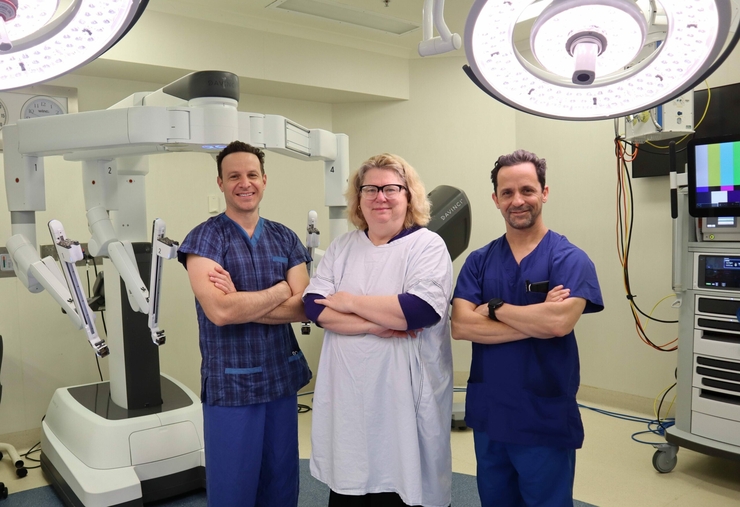Robot technology has revolutionised treatment options and healthcare outcomes at St Andrew's War Memorial Hospital, which is celebrating a notable milestone.
The Brisbane hospital's robotic surgery teams have performed 500 procedures since the da Vinci Xi system arrived three years ago, despite the challenges of the COVID-19 pandemic.
Its surgeons are now looking forward to extending the benefits of the technology to as many patients as possible, as its potential applications progress.
"Robotics is the way of the future," said St Andrew's Director of Gynaecology and Medical Advisory Chair,Dr Caron Forde, who was the first at the hospital to perform a procedure with the fourth-generation robot in October 2019.
"Surgery and surgical techniques have always evolved. Open surgery worked very well but laparoscopic, or keyhole surgery, was a marked improvement and now most surgery is minimally invasive. Robotics is the next step in the process," she added.
Dr Forde said she began her 'journey' with the technology when she supported urologists' bid to bring a robot to the UnitingCare hospital.
"I was very impressed by the advantages the robot provided and thought, 'Why not use this for women as well!'" she said.
"Hysterectomy and endometriosis surgery were the first areas to benefit, followed by pelvic floor and prolapse repairs, bladder repairs, treatment of all ovarian cysts, reversal of tubal ligation and fertility surgery."
Urological surgeonDr Jason Paterdis, who began using robotics 13 years ago, said the technology had revolutionised his patients' outcomes with minimally-invasive techniques.
"In its infancy, the robot was used mainly for robotic radical prostatectomy in the treatment of localised prostate cancer. We are now using the robot for most procedures involving the kidney, ureters, bladder and prostate, mainly for the treatment of malignancy," he said.
"Robotics has greatly improved patient outcomes, particularly reducing length of stay, pain and need for blood transfusions. In the long term, it has proven functional benefits, particularly an improvement in urinary control and sexual function in patients treated for prostate cancer."
Dr Forde said robotics had helped her provide patients with safer surgery and faster recovery, while giving women greater choice of treatment for their specific health problems.
"In a practical sense, this means women can be back at work within a week or two of their hysterectomy," she said.
"Women with endometriosis have less disruption of their healthy pelvic tissues, so there is less long-term scarring, with better outcomes, and reduced long-term symptoms. Women with prolapses and incontinence have surgical options so their repair can be tailor-made."
Dr Paterdis is looking forward to a future where surgery is even less invasive, and procedures can be performed virtually from long distance to open up access for patients in remote areas.
"I think robotics is heading to single-incision surgery, with more flexible instruments and blending of radiological and anatomical anatomy," he said.
"I also hope to see 'tele-robotics' performed in major centres for rural patients, whilst they stay in their home towns."
Robotic surgery is available to St Andrew's patients across an expanding range of specialities, also including colorectal, but Dr Ryan Sommerville said it was still in its early stages of development in his field – ear, nose and throat (ENT), and head and neck surgery.
"The most common use is for removal of cancers of the tonsil or the base of the tongue. Often this can mean the patient is able to avoid radiotherapy and chemotherapy," he said.
"The second is as part of sleep apnoea surgical management. In appropriate patients, where large lingual tonsils reduce the amount of space at the back of the tongue, we can remove the tonsils, thereby improving the airway calibre at that level."
As robotic surgery develops in ENT, Dr Sommerville said it would improve access to many areas in the head and neck.
"I would like to think with the combination of 3D high-resolution visualisation that can see around corners, multiple operative arms, smaller and smaller instruments, and incorporation of other operative technologies, in the future we will see robotics used in other areas such as the skull base, deep neck spaces and sinuses," he said.
Read more: Brisbane hospital offers 'world-leading' robot surgery
Read more: First anniversary for 'incredibly important' breast care
Next On The Ground:
12/9/2022 A new life for used medication packs
Previous On The Ground:
31/8/2022 Health workforce shortage fix needs a national approach
![[APHA]](/images/logo_apha.svg)
